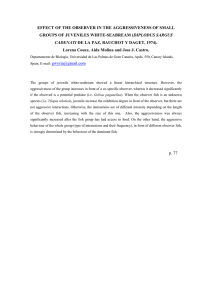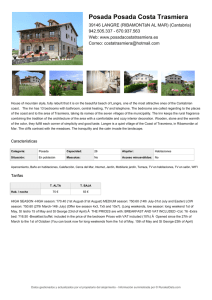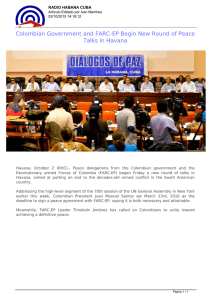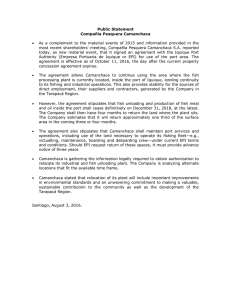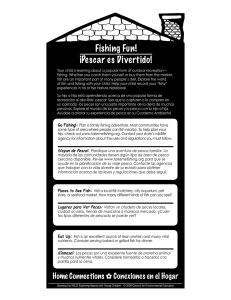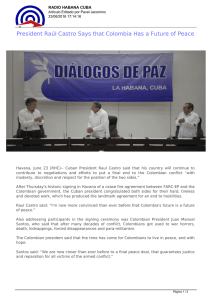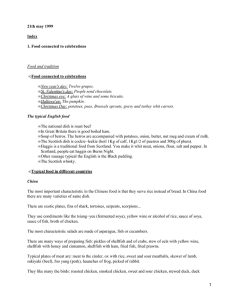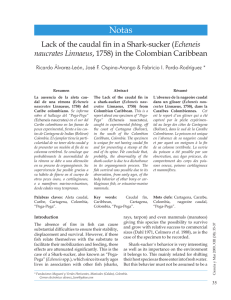Diet and feeding ecology of the little tunny, Euthynnus alletteratus
Anuncio
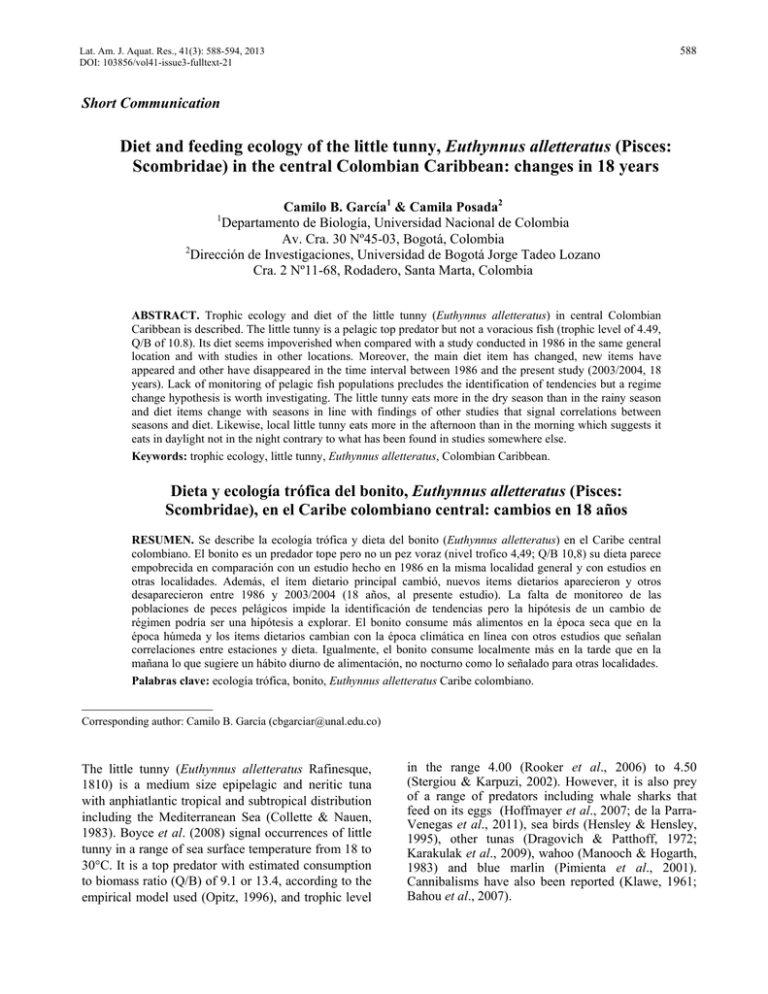
Lat. Am. J. Aquat. Res., 41(3): 588-594, 2013 of Euthynnus alleteratus in central Colombian Caribbean Feeding DOI: 103856/vol41-issue3-fulltext-21 588 Short Communication Diet and feeding ecology of the little tunny, Euthynnus alletteratus (Pisces: Scombridae) in the central Colombian Caribbean: changes in 18 years Camilo B. García1 & Camila Posada2 1 Departamento de Biología, Universidad Nacional de Colombia Av. Cra. 30 Nº45-03, Bogotá, Colombia 2 Dirección de Investigaciones, Universidad de Bogotá Jorge Tadeo Lozano Cra. 2 Nº11-68, Rodadero, Santa Marta, Colombia ABSTRACT. Trophic ecology and diet of the little tunny (Euthynnus alletteratus) in central Colombian Caribbean is described. The little tunny is a pelagic top predator but not a voracious fish (trophic level of 4.49, Q/B of 10.8). Its diet seems impoverished when compared with a study conducted in 1986 in the same general location and with studies in other locations. Moreover, the main diet item has changed, new items have appeared and other have disappeared in the time interval between 1986 and the present study (2003/2004, 18 years). Lack of monitoring of pelagic fish populations precludes the identification of tendencies but a regime change hypothesis is worth investigating. The little tunny eats more in the dry season than in the rainy season and diet items change with seasons in line with findings of other studies that signal correlations between seasons and diet. Likewise, local little tunny eats more in the afternoon than in the morning which suggests it eats in daylight not in the night contrary to what has been found in studies somewhere else. Keywords: trophic ecology, little tunny, Euthynnus alletteratus, Colombian Caribbean. Dieta y ecología trófica del bonito, Euthynnus alletteratus (Pisces: Scombridae), en el Caribe colombiano central: cambios en 18 años RESUMEN. Se describe la ecología trófica y dieta del bonito (Euthynnus alletteratus) en el Caribe central colombiano. El bonito es un predador tope pero no un pez voraz (nivel trofico 4,49; Q/B 10,8) su dieta parece empobrecida en comparación con un estudio hecho en 1986 en la misma localidad general y con estudios en otras localidades. Además, el ítem dietario principal cambió, nuevos ítems dietarios aparecieron y otros desaparecieron entre 1986 y 2003/2004 (18 años, al presente estudio). La falta de monitoreo de las poblaciones de peces pelágicos impide la identificación de tendencias pero la hipótesis de un cambio de régimen podría ser una hipótesis a explorar. El bonito consume más alimentos en la época seca que en la época húmeda y los ítems dietarios cambian con la época climática en línea con otros estudios que señalan correlaciones entre estaciones y dieta. Igualmente, el bonito consume localmente más en la tarde que en la mañana lo que sugiere un hábito diurno de alimentación, no nocturno como lo señalado para otras localidades. Palabras clave: ecología trófica, bonito, Euthynnus alletteratus Caribe colombiano. ___________________ Corresponding author: Camilo B. García ([email protected]) The little tunny (Euthynnus alletteratus Rafinesque, 1810) is a medium size epipelagic and neritic tuna with anphiatlantic tropical and subtropical distribution including the Mediterranean Sea (Collette & Nauen, 1983). Boyce et al. (2008) signal occurrences of little tunny in a range of sea surface temperature from 18 to 30°C. It is a top predator with estimated consumption to biomass ratio (Q/B) of 9.1 or 13.4, according to the empirical model used (Opitz, 1996), and trophic level in the range 4.00 (Rooker et al., 2006) to 4.50 (Stergiou & Karpuzi, 2002). However, it is also prey of a range of predators including whale sharks that feed on its eggs (Hoffmayer et al., 2007; de la ParraVenegas et al., 2011), sea birds (Hensley & Hensley, 1995), other tunas (Dragovich & Patthoff, 1972; Karakulak et al., 2009), wahoo (Manooch & Hogarth, 1983) and blue marlin (Pimienta et al., 2001). Cannibalisms have also been reported (Klawe, 1961; Bahou et al., 2007). 589 Latin American Journal of Aquatic Research The diet of little tunny has been described from a number of places. Authors concur in that little tunny is an opportunistic species just eating what is available which is not surprising for an extended species. Thus Bahou et al. (2007) list for the Ivory Coast as much as 21 fish species and Manooch et al. (1985) for southeastern and gulf coasts of the United States list 23 fish species as part of its diet, and in both cases with a long complement of invertebrates. Interestingly in Ivory Coast the main items were demersal fishes (Priacanthus arenatus and Trichiurus lepturus) whereas in southeastern United Sates main items were small pelagic fishes (Sardinella aurita). In the central Mediterranean Sea, Faulatano et al. (2007) reported Maurolicus muelleri, a bathypelagic fish, as main prey item. In Venezuela, Etchevers (1976) reported that Sardinella anchovia (currently S. aurita) was an important prey item in the diet of this species. Changes in the prevalence and size of dietary items related to season and growth of individuals have been detected. Bahou et al. (2007) found that scombrids in Ivory Coast were significantly more important in the upwelling season than otherwise. These authors also found a positive correlation between fish prey size and little tunny size as Faulatano et al. (2007). Sylva & Rathjen (1961) and Manooch et al. (1985) found migratory movements off southeastern United States with little tunny moving southwards in fall/spring and northwards in summer. Manooch et al. (1985) mentioned that prevalence of fish with respect to invertebrates increased with size of little tunny. The little tunny is a visitor of artificial reefs (Rooker et al., 1997; Arena et al., 2007) and fish aggregation devices (Menard et al., 2000). In Colombian Caribbean waters the litte tunny (locally known as “bonito”) is incidentally fished by the artisanal fleet (e.g., Criales-Hernández et al., 2006). On the basis of interviews to fishermen, Garcia (2010) found that the little tunny is used for consumption and as bait but it does not qualify in the top 11 species of interest for them (C.B. García, unpublished data). In the study area (see below) landings of little tunny occur the year round with a slight increase the second part of the year (mostly the rainy season), although monthly multiannual mean landings as kg/trip are very variable (GómezCanchong et al., 2004). The only diet study of little tunny in Colombian Caribbean waters is that of Moreno (1986): clupeoids (Harengula sp., Sardinella sp. Ophistonema oglinum) and carangids (Decapterus sp.) were found to be the main diet items. This study presents the diet of little tunny as of 2003 and 2004 (see below) contrasted with the data of Moreno (1986), reports its Q/B and trophic level and determines whether the seasons (dry vs. rainy season) and the time of capture (morning vs afternoon but not in the night) have influence on the diet. Sampling was done in Taganga Bay and the National Natural Park Tayrona (NNPT), situated on the central Colombian Caribbean Sea (11°21´00”11°15´33”N, 73°54´06”-74°12´33”W). This coastal zone is influenced by the Caribbean Current, generated by the trade winds (“Alisios”), and the Panama-Colombia Countercurrent and is characterised for presenting a seasonal upwelling during the dry season that goes from December to April (Ramírez, 1990; Andrade, 2001). Fishes were captured by artisanal fishermen during their routine work with beach seines and by trolling (fishermen use both fish and artificial lures) from March 2003 to May 2004, thus covering the dry (December to April) and the rainy (May to November) seasons. Times of capture were before and afternoon but not in the night. Individuals were weighted, measured (fork length in cm) and sexed, and their stomachs were immediately removed and injected with a buffered solution of ethilic alcohol (70%), neutralised formaldehyde (10%) and marine water in proportion 4:1:3. The stomachs were refrigerated until their analysis. Prey items were enumerated, identified to the lowest possible taxonomic level and weighted (wet weight). Results and analysis are given in terms of weight as descriptions like frequency of occurrence are useless for trophic modeling (see Stobberup et al., 2009). Unidentifiable stomach material, i.e. material too digested to be identifiable even as appendices or other body parts amounted to 4.9% in average weight. This material was excluded in subsequent percentage weight calculations. General categories made of identifiable body parts, for instance, “teleosts” were distributed proportionally among identified fish species or genera and so on. The consumption/biomass (Q/B) ratio was estimated by means of an empirical model proposed by Palomares & Pauly (1998) that for carnivore fishes is: Q/B = 10 [(7.964 - 0.204 * log W ∞ - 1.965 *(1000/ (Tc + 273.15)) + 0.083 * A] where W∞ is the asymptotic weight of the individuals (wet weight, in g), Tc is the mean annual habitat temperature for the fish population in question (in °C) and A is the aspect ratio of the caudal fin (unitless). The asymptotic weight (W∞) was estimated considering the maximum size of little tunny reported for the study area (Moreno, 1986), using the relation proposed by Pauly (1986): Feeding of Euthynnus alleteratus in central Colombian Caribbean W∞ = Wmax /0.86 Sea surface temperature was registered between September 2002 and March 2004 in Taganga Bay (n = 57) to obtain mean annual habitat temperature. The aspect ratio (A) of the caudal fin, a measurement of fish activity (Pauly, 1986) was estimated as: A = h² s-1 where h is the distance between the upper and lower lobule and s is the surface area of the caudal fin (n = 22). Fins were projected on millimetre paper to estimate s. Trophic level (defined as the weighted mean trophic level of prey items) of little tunny was estimated using the application TrophLab (Pauly et al., 2000). TrophLab allows three levels of taxonomic resolution of diets and postulates trophic levels for preys in the diets. Thus percentage weight was assigned to items according to constrains in TrophLab. See García & Contreras (2011) for a review of Colombian Caribbean fishes trophic levels. Resampling procedures (see, for instance, Manly, 1998, for an introduction of such methods in biology) were used to test whether mean fork length, mean fish weight and mean weight of stomach content (including unidentifiable material) were different (one tailed tests) between seasons (dry vs rainy season) and between time of capture (6 to 13 h, in the morning, vs 13 to 18 h, in the afternoon). Routines for the effect were written with the program Statistics 101, v. 1.5.3 (http://www.statistics101.net/) whereby the data of the two groups to be compared are combined and resampled with replacement iteratively, the difference of the two resample means at each iteration is recorded and the percentage of time that this difference is equal or exceeded the observed difference is taken as the P-value. Bias corrected 95% bootstrap confidence intervals were fitted to means A total of 46 stomachs were collected of which 44 contained food. Table 1 shows the general diet of little tunny in 2003/2004 compared to what Moreno (1986) found (1985/1986). Diet in 2003/2004 seems impoverished with respect to 1985/1986. At family level clupeoids are still the most important prey item followed by carangids, but a number of fish families do not appear in 2003/2004 while mugilids were absent in 1986. At genera and species level there are less items, some items have changed importance, some have disappeared and some are new in 2003/2004 compared to 1985/1986. Notably the dwarf herring (Jenkinsia lamprotaenia) has become the main single dietary item in 2003/2004 while absent in 1986. Squids were present in 2003/2004 but absent in 1985/1986 (Table 1). 590 588 The Q/B ratio estimated for little tunny was 10.8 meaning that this fish consumes 10.8 times its own weight in a year. These Q/B ratio is less than that reported by Opitz (1996) of 13.4 using the same empirical model as here. Estimated trophic level was 4.49 that compares well with the 4.47 trophic level estimated for Moreno´s (1986) data (García & Contreras 2011) and the 4.50 trophic level estimated by Stergiou & Karpuzi (2002) but it is somewhat far from the estimate of 4.00 estimated by Rooker et al. (2006). Table 2 shows mean values, range and confidence intervals for stomach content, fork length and fish weight according to season and capture time. Means for fork length and fish weight were rather similar to each other both in terms of season and capture time (Table 2). Interestingly mean values for stomach content for both the dry season and capture time afternoon were notably higher compared to their counterparts (Table 2). Hypothesis tests, however, turned out to be not significant (P > 0.05) with the exception of the comparison dry season vs. rainy season for stomach content that was marginally significant (P = 0.07). Diet of little tuna in the central Colombian Caribbean looks poor in terms of taxonomic richness compared to what has been reported elsewhere. Joining the lists of Moreno (1986) and this study 11 fish species and one family were found in the stomachs (Table 1) in contrast to 21 and 23 fish species reported by Bahou et al. (2007) and Manooch et al. (1985), respectively. One first reason for this finding may be the different number of stomachs (with food) sampled in the studies: 166 in the case of Bahou et al. (2007) and as much as 1212 in the case of Manooch et al. (1985) versus 109 adding Moreno (1986) and this study. Nevertheless it is an open question in which extension local diversity influences this result. The impression of impoverishment is also valid when comparing Moreno (1986) and this study (Table 1). The reason for the impoverished diet of little tunny as of 2003/2004 compared to its diet in 1985/1986 is not clear. Differences in stomach numbers (with food), 44 in this study, 65 in the study of Moreno (1986) might explain this finding but further sampling would be needed to obtain conclusive evidence. More intriguing are the differences in the taxonomy of diet items and in the ranking of common diet items, taking into account that the study area is almost the same and that sampling in both studies covered most of the year. Lack of monitoring in the area precludes identification of trends in local fish pelagic populations or characterization of their dynamics. Regime shifts that 591 589 Latin American Journal of Aquatic Research Table 1. Comparison of diet of Euthynnus alletteratus in 1985/1986 (modified from Moreno, 1986) and 2003/2004 (this study). %W: percentage weight. This study Moreno (1986) Diet items Fish Family %W Diet items Fish Family %W Jenkinsia lamprotaenia Sardinella aurita Decapterus sp. Mugil curema Opisthonema oglinum Harengula humeralis Loligo sp. Sepioteuthis sepioidea Coronis sp. Clupeidae Clupeidae Carangidae Mugilidae Clupeidae Clupeidae 34.9 19.5 15.6 10.2 8.8 7.5 1.7 1.1 0.8 Decapterus sp. Harengula sp. Sardinella sp. Hemiramphus brasiliensis Opisthonema oglinum Ictioplancton Anchoviella sp. Coronis sp. Squilla sp. Dactylopterus volitans Engraulis eurystole Anchoa sp. Synodontidae Penaeidae Zoeas Carangidae Clupeidae Clupeidae Hemiramphidae Clupeidae 29.7 20.4 17.8 12.5 7.1 5.4 2.0 1.6 1.4 1.3 0.4 0.1 0.1 0.1 0.1 Engraulidae Dactylopteridae Engraulidae Engraulidae Synodontidae Table 2. Mean stomach content (wet weight, g, including unidentifiable material), fork length (cm) and body weight (wet weight, g) of little tunny (Euthynnus alletteratus) according to season and sampling time in the central Colombian Caribbean. N for the rainy season = 28 stomachs; N for the dry season = 16 stomachs; N for morning (00 to 13 hours) = 13 stomachs; N for afternoon (13 to 18 h) = 31 stomachs. Confidence Intervals are bias corrected 95% bootstrap confidence intervals. Stomach content Rainy season Dry season Morning Afternoon Fork length Rainy season Dry season Morning Afternoon Fish weight Rainy season Dry season Morning Afternoon Range Mean 0.02-38.49 0.16-84.86 0.02-34.50 0.05-84.86 6.65 13.90 6.39 10.50 3.34-11.00 5.97-27.19 2.37-12.74 5.58-18.14 25.50-54.45 25.50-51.90 32.04-54.45 25.50-49.00 38.15 36.17 38.41 37.02 36.01-40.55 32.59-40.29 34.54-43.13 34.83-39.19 250.00-1843.75 250.00-1650.00 437.50-1843.75 250.00-1650.00 822.25 783.91 834.36 797.38 694.94-974.33 564.30-1039.77 607.21-1132.21 646.25-911.46 affect the suite and relative abundance of species have been postulated for pelagic ecosystems in other latitudes but not for the Caribbean where the focus has Confidence Interval been on the shift from stony coral dominated reefs to macroalgae dominated reefs (e.g., Folke et al., 2004). A hypothesis to be tested is that the pelagic ecosystem Feeding of Euthynnus alleteratus in central Colombian Caribbean in the central Colombian Caribbean Sea has undergone some regime shift in the course of the last 20 years. The dwarf herring (Jenkinsia lamprotaenia), main prey item in 2003/2004 and absent in 1985/1986, has been previously reported as food for little tunny. Bullis & Juhl (1967) described the feeding behaviour of little tunny in the night when attacking an aggregation of dwarf herring in the Lesser Antilles. Thus its emergence and predominance in the diet of little tunny in 2003/2004 suggest an increase in its relative availability to little tunny in the study area as it is also native to Caribbean Colombian waters. García & Duarte (2002) made a compilation of Caribbean fishes Q/B values and found that scombrids were positioned in a middle point in a ranking of Q/B values, i.e., they are not particularly voracious. Although they are highly mobile (first position in the ranking of aspect ratios) that correlates positively with Q/B, they also occupied a high position in body weight that correlates negatively with Q/B (Palomares & Pauly, 1998; García & Duarte, 2002). The status of little tunny as a top predator is confirmed here. The remarkably consistency of trophic level estimates in the different studies, however, is at least partly due to the constrains in taxonomic resolution of diets in TrophLab (Pauly et al., 2000) that tends to homogenize diets. As fork length and fish weight were found not to differ between seasons and between capture times, the difference in stomach weight between seasons and between sampling times (Table 2) are not unduly influenced by those variables. In the study area little tunny eats in average more in the dry season which is characterized by an upwelling phenomenon rather than in the rainy season. However, the supply of nutrients in the rainy season due to continental discharges is not much different than nutrients supplied by deep water (Ramírez, 1987, 1990) thus the upwelling manifests just as lower sea temperatures and higher salinities compared to the rainy season and not so much in dramatic changes in primary production (Franco-Herrera et al., 2006). Nevertheless the change from dry season to rainy season is not without biological consequences. Thus, for instance, in the dry season schools of juveniles from the Mugilidae family (Mugil incilis, M. liza and M. curema) migrate from the northern Colombian Caribbean into the Ciénaga Grande de Santa Marta (CGSM), the biggest coastal lagoon of the region (Sánchez & Rueda, 1999). Transit of shrimp larvae and juveniles in and out of the CGSM correlates with 588 592 the seasons (Lopez & García, 2001), time series of CPUE for pelagic and demersal fishes is influenced by both biological and ultimately by climate factors (Manjarrés-Martínez et al., 2010), both total and the fraction of herbivorous zooplankton biomass is higher when the trade winds are blowing, i.e., the dry season (Bernal et al., 2004). Although the uneven number of stomachs in the comparisons of seasons and capture times (Table 2) and the high variability in presence/absence of items among the stomachs (with most stomachs showing just one or two items) precluded a formal multivariate comparison of diets, there is indication of qualitative differences in the diet of little tunny with season. Thus, in the dry season the predominance in the diet corresponded to Sardinella aurita, not Jenkinsia lamprotaenia, and several taxa appear (notably Mugil curema and Ophistonema oglinum) that are not present in the rainy season and vice versa, notably Harengula humeralis, although the last observation may partly be dependent of the processing of the data (the proportional distribution of the general category “teleosts” among identified taxa). In balance, both the quantitative and qualitative observations of the diet of little tunny signals to a well defined correlation with climate. Further observations more extended in time are needed to untangle the web of dependent and independent variables involved and to decide whether causal relationships exists and which are they in the shaping of the diet of little tunny. Authors concur in the observation of seasonal changes in the diet of little tunny in several locations, e.g., Sylva & Rathjen (1961), Manooch et al. (1985) and Bahou et al. (2007). In average little tunny eats more in the afternoon than in the morning (Table 2), although the difference is not statistically significant due to high variability in the data. Bahou et al. (2007) concluded that it feeds at night and the observations of feeding behavior by Bullis & Juhl (1967) were done at night. On the other hand, tunas are reputedly visual predators although deep dives probably for feeding have been reported for various species, e.g., Dagorn et al. (2006) and Wilson & Block (2009). The finding here of fuller stomachs in the afternoon suggests that little tunny in our study area is eating during day light. A 24 h monitoring would be needed to settle the matter. ACKNOWLEDGEMENTS Comments by two anonymous reviewers helped to improve the manuscript. 593 589 Latin American Journal of Aquatic Research REFERENCES Andrade, C.A. 2001. Las corrientes superficiales en la cuenca de Colombia observadas con boyas de deriva. Rev. Acad. Colombiana Cienc., 25(96): 321-335. Arena, P.T., L.K. Jordan & R.E. Spieler. 2007. Fish assemblages on sunken vessels and natural reefs in southeast Florida. Hydrobiologia, 580: 157-171. Bahou, L., T. Kone, V. N’Douba, K.J. N’Guessan, E.P. Kouamelan & G.B. Gouli. 2007. Food composition and feeding habits of little tunny (Euthynnus alletteratus) in continental shelf waters of Côte d’Ivoire (west Africa). ICES J. Mar. Sci., 64: 10441052. Bernal, A., B. Werding & S. Zea. 2004. Variación especial y temporal de biomasa zooplanctónica en el sector nerítico del mar Caribe colombiano. In: N.H. Campos & A. Acero (eds.). Contribuciones en ciencias del mar en Colombia. Investigación y desarrollo de territorios promisorios. Red de estudios del mundo marino, Universidad Nacional de Colombia, Bogotá, pp. 187-196. Boyce, D.G., D.P. Tittensor & B. Worm. 2008. Effects of temperature on global patterns of tuna and billfish richness. Mar. Ecol. Prog. Ser., 355: 267-276. Bullis, H.R. & R. Juhl. 1967. Phalanx orientation in feeding behavior of the little tunny, Euthynnus alletteratus. Trans. Am. Fish. Soc., 96: 122-125. Collette, B.B. & C.E. Nauen. 1983. Scombrids of the world. An annotated and illustrated catalogue of tunas, mackerels, bonitos, and related species known to date. FAO Fish. Synop., 125(2): 1-137. Críales-Hernández, M.I., C.B. García & M. Wolff. 2006. Flujos de biomasa y estructura de un ecosistema de surgencia tropical en la Guajira, Caribe colombiano. Rev. Biol. Trop., 54(4): 1257-1282. Dagorn, L., K.N. Holland, J.P. Hallier, M. Taquet, G. Moreno, G. Sancho, D.G. Itano, R. Aumeeruddy, C. Girard, J. Million & A. Fonteneau. 2006. Deep diving behavior observed in yellowfin tuna (Thunnus albacares). Aquat. Living Resour., 19: 85-88. De la Parra-Venegas, R., R. Hueter, J. González-Cano, J. Tyminski & J. Gregorio-Remolina. 2011. An unprecedented aggregation of whale sharks, Rhincodon typus, in Mexican coastal waters of the Caribbean Sea. PLoS ONE, 6(4): e18994. doi:10.1371/journal.pone.0018994 Dragovich, A. & T. Potthoff. 1972. Comparative study of food of skipjack and yelowfin tunas off the coast of west Africa. Fish. Bull., 70(4): 1087-1110. Etchevers, S.L. 1976. Incidencia de clupeoides en la alimentación de las cabanas: Euthynnus alleteratus (Rafinesque) y Auxis tazard (Lacépède) en la costa nordeste de Margarita (Venezuela). Lagena, 37-38: 911. Faulatano, M., L. Castriota, M. Grazia & F. Andaloro. 2007. Feeding ecology of little tunny Euthynnus alletteratus in the central Mediterranean Sea. J. Mar. Biol. Assoc. U.K., 87: 999-1005. Folke, C., S. Carpenter, B. Walker, M. Scheffer, T. Elmqvist, L. Gunderson & C.S. Holling. 2004. Regime shifts, resilience, and biodiversity in ecosystem management. Annu. Rev. Ecol. Syst., 35: 557-81. Franco-Herrera, A., L. Castro & P. Tigrero. 2006. Plankton dynamics in the South-Central Caribbean Sea: strong seasonal changes in a coastal tropical system. Caribb. J. Sci., 42(1): 24-38. García, C.B. & L.O. Duarte. 2002. Consumption to biomass (Q/B) ratio and estimates of Q/B-predictor parameters values for Caribbean fishes. Naga ICLARM Quart., 25(2): 19-31. García, C.B. 2010. Conocimiento tradicional: lo que los pescadores artesanales del Caribe colombiano tienen para decirnos. Pan-Am. J. Aquat. Sci., 5(1): 78-90. García, C.B. & C.C. Contreras. 2011. Trophic levels of 119 Colombian Caribbean fish species of commercial importance. Rev. Biol. Trop., 53(3): 1195-1203. Gómez-Canchong, P., L. Manjarrés, L.O. Duarte & J. Altamar. 2004. Atlas pesquero del área norte del Mar Caribe de Colombia. Universidad del Magdalena, Santa Marta, 230 pp. Hensley, V.I. & D.A. Hensley. 1995. Fishes eaten by sooty terns and brown noddies in the dry Tortugas, Florida. Bull. Mar. Sci., 56(3): 813-821. Hoffmayer, E.R., J.S. Ranks, W.B. Driggers, K.J. Oswald & J.M. Quattro. 2007. Observations of a feeding aggregation of whale sharks, Rhincodon typus, in the north central Gulf of Mexico. Gulf Caribb. Res., 19(2): 69-73. Karakulak, F.S., A. Salman & I.K. Oray. 2009. Diet composition of bluefin tuna (Thunnus thynnus L. 1758) in the eastern Mediterranean Sea, Turkey. J. Appl. Ichthyol., 25: 757-761. Klawe, W.L. 1961. Young scombrids from the waters between Cape Hatteras and Bahama Islands. Bull. Mar. Sci., 11(1): 150- 157. Lopez, A.C. & C.B. García. 2001. Poslarvas y juveniles de Farfantopenaeus spp. y Xiphopenaeus kroyeri en la Boca de la Barra (Ciénaga Grande de Santa Marta, Caribe colombiano. Bol. Invest. Mar. Cost., 30: 177198. Manly, B.F.J. 1998. Randomization, bootstrap and montecarlo methods in biology. Chapman & Hall, London, 399 pp. Feeding of Euthynnus alleteratus in central Colombian Caribbean Manjarrés-Martínez, L.M., J.C. Gutiérrez-Estrada, J. Mazenet-González & M.C. Soriguer. 2010. Seasonal patterns of three fish species in a Caribbean coastal gill-net fishery: biologically induced or climaterelated aggregations? Fish. Res., 106: 358-367. Manooch, C.S. & W.T. Hogarth. 1983. Stomach contents and giant trematodes from wahoo, Acanthocybium solanderi, collected along the south Atlantic and Gulf coasts of the United States. Bull. Mar. Sci., 33(2): 227-238. Manooch, C.S., D.L. Mason & R.S. Nelson. 1985. Foods of little tunny Euthynnus alleteratus collected around the southeastern and Gulf coasts of the United States. Bull. Jpn. Soc. Sci. Fish, 51(8): 1207-1218. Menard, F., A. Fonteneu, D. Gaertned, B. Nordstrom, B. Stequert & E. Marchal. 2000. Exploitation of small tunas by a purse-seine fishery with fish aggregation devices and their feeding ecology in an eastern tropical Atlantic ecosystem. ICES J. Mar. Sci., 57: 525-530. Moreno, R. 1986. Ecología trófica de algunas especies de la familia Scombridae capturados en aguas costeras del departamento del Magdalena, Caribe Colombiano. Tesis de Biología. Universidad Nacional de Colombia, Bogotá, 105 pp. Opitz, S. 1996. Trophic interactions in Caribbean coral reefs. ICLARM Tech. Repp., 43: 1-341. Palomares, M.L. & D. Pauly. 1998. Predicting fish consumption of fish populations as functions of mortality, food type, morphometrics, temperature and salinity. Austr. J. Mar. Fresh. Res., 49: 447-453. Pauly, D. 1986. A simple method for estimating the food consumption of fish population from growth data and food conversion experiments. Fish. Bull., 84(4): 827840. Pauly, D., R. Froese, P. Saa, M.L. Palomares, V. Christensen & J. Rius. 2000. TrophLab in MS Access. http://www.fishbase.org/download/TrophLab2K.zip http://www.fishbase.org/download/TrophLab2K.zip Reviewed: 30 May 2010. Received: 21 August 2012; Accepted: 8 May 2013 588 594 Pimienta, E.G., F.R. Marques, G.S. Lima & A.F. Amorim. 2001. Marlin Project: tag-and-release, biometrics and stomach content of billfish in Cabo Frio city, Rio de Janeiro, Brazil. Coll. Vol. Sci. Pap. ICCAT, 53: 371-375. Ramírez, G. 1987. Características hidroquímicas y composición química de los sedimentos de la Bahía de Nenguange, Caribe colombiano. Anal. Inst. Invest. Mar. Punta de Betín, 17: 15-26. Ramírez, G. 1990. Evaluación de parámetros hidrográficos y su relación con la surgencia en las aguas costeras. In: J.M. Díaz (ed.). Estudio ecológico integrado de la zona costera de Santa Marta y Parque Nacional Natural Tayrona. INVEMAR, Informe Final, Santa Marta, pp. 19-54. Rooker, J.R., Q.R. Dokken, C.V. Pattengill & G.J. Holt. 1997. Fish assemblages on artificial and natural reefs in the Flower Garden Banks National Marine Sanctuary, USA. Coral Reefs, 16: 83-92. Rooker, J.R., J.P. Turner & S.A. Holt. 2006. Trophic ecology of Sargassum-associated fishes in the gulf of Mexico determined from stable isotops and fatty acids. Mar. Ecol. Prog. Ser., 313: 249-259. Sánchez, C. & M. Rueda. 1999. Space-time variation of the diversity and abundance of dominant fish species in the Magdalena River Delta, Colombia. Rev. Biol. Trop., 47: 1067-1079. Stergiou, K.I. & V. Karpouzi. 2002. Feding habits and trophic level of Mediterranean fish. Rev. Fish Biol. Fish., 11: 217-254. Stobberup, K.A., T. Morato, P. Amorim & K. Erzini. 2009. Predicting weight composition of fish diet’s: converting frequency of occurrence of prey to relative weight composition. Open Fish Sci. J., 2: 42-49. Sylva, D. & W.F. Rathjen. 1961. Life history notes on the little tuna, Euthynnus alletteratus, from the southeastern United States. Bull. Mar. Sci., 11(2): 161-190. Wilson, S.G. & B.A. Block. 2009. Habitat use in Atlantic bluefin tuna Thunnus thynnus inferred from diving behavior. Endang. Species Res., 10: 355-367.
